Last Updated: Apr 23, 2009
(1) The Lectionary Editing Process
(2) Mixture by M3
(3) Advancing the Stemma
(4) Comparison to von Soden
(5) The Alexandrian Stream
(6) The Latin Branch of Transmission
(7) Limits of Alexandrian Influence
(8) No Stemma for Alexandrian Stream
(9) So-Called Alexandrian Stemma
(10) An Honest Alexandrian Stemma
Lets have a closer look at the editing process that created the Lectionary text:
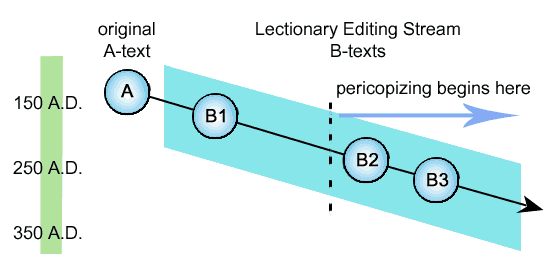
We can do even better than this, by teasing out the details using a combination of examining key individual variation units and readings, and also fleshing out the various steps in the editing process, a process that spans several hundred years.
Surprisingly, pretty much all the serious variants have been preserved in the extant textual groups (keep in mind these are whole families of manuscripts, not just individual mss). From these we can draw out the major edits and readings which were adopted at least temporarily by others in carrying on the Lectionary tradition.
Note how closely this process has been diagrammed to the extant groups M1...M4:
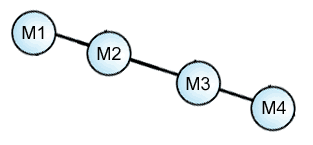
This is partly our choice of layout, but it is no accident. We will in fact reconstruct the B-text process largely by consulting this line of groups which are known to be clearly related to the Lectionary text. In fact it was this very relationship (excepting M1-M2) that led von Soden to connect them directly in his own stemma.
However, the groups themselves are generally very late, and are more likely to have independantly descended from the earlier editing process and archetypes now long lost. That is, the manuscripts themselves are not directly copied from each other, in spite of their close similarities in this short passage.
We should ever keep in mind that the manuscripts themselves form a diverse group of independant witnesses in time and geographical location, and that in other places their text can diverge considerably. This indeed shows they have come down to us independantly from various stages of a long and widespread editing process.
Indeed, although all the manuscripts can be loosely catalogued as 'Byzantine', 'Caesarian', or 'Western', or some mixture, they cannot be connected directly in any kind of stemma themselves.
The stemmas in the case of the Byzantine text-type must be reserved for the underlying editing and copying processes from which the manuscripts are distantly descended.
We will take M5 as a base for the A-text, and M6 as the base for the B-text, since we have good grounds already to do so. (these are the two dominant texts for the whole Middle Ages).
Again we make an interesting observation regarding M3 having to do with the order of the variant units and the readings:
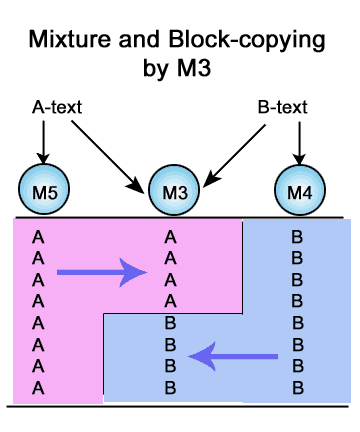
The M3 text actually copies the A-text for the first three verses, then follows the B-text for the rest (with a few minor variations).Once again we see the phenomenon of 'block-copying', and again, the virtual foregone conclusion is that M3 is the culprit.
The scribe who created M3 had access to both the A and B texts, and followed one, then the other.
The alternative again would require a far more complicated process, a later date for the texts, and needless multiple sources. (we even have to use *3* letters just to designate the readings, since we cannot assume the source.)
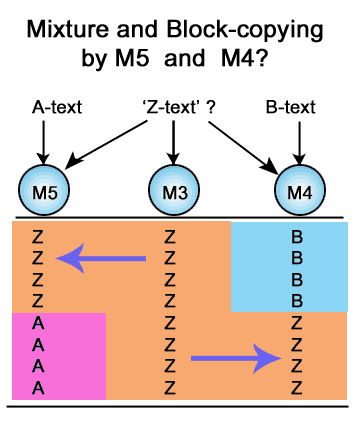
M4 and M5 would have to have identical but inverse copying habits, using the 'Z-text' in a contrary manner. This is extremely implausible once again.
The meaning for our inquiry is simple:
M3 is a late text possibly created out of M5 and M4 (the mature Lectionary text). In fact, the archetype of M3 probably just copied the first three verses for the obvious reason that he was reinserting the pericope back into the transmission stream, and needed the connecting material to the previous section (John 7). But otherwise, this copyist prefered the familiar Lectionary text, it being read in public services.
This means that any quirks of M3 are probably of his own design, and not part of the earlier evolving Lectionary editing process. The handful of peculiar readings in M3 can be assigned directly to the archetype of M3 and discarded.
Instead, we give priority to M4, although it is probably the last edit tracable to the actual B-text (Lectionary) editing process. This is a mixed blessing for textual critics: although many would like to assign an earlier date than the 9th century for the text of M4 (Family 13 et al.), this text will be the very last edition of the Lectionary, before the use of Greek finally faded away and Latin became dominant.
Just as M1 turned out by its weakness of connection to be secondary to M2, M3 has turned out to be secondary to M4:
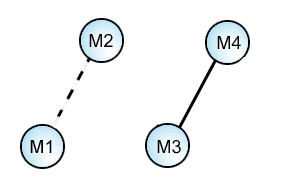
The relation of M2 to M4 is another question.
In fact, we can be more precise in formulating our question:
Did the archetype of M2 simply develop out of M6 (its closest relative group) in a retrograde fashion (being corrected back to the M5 text on a few readings?), or did M2 have a life of its own as a primitive Lectionary text prior to the 'Pericopizing' step of the standard Lectionary?
Since we have little evidence in the way of either ancient manuscripts or multitudinous copies of the M2 text, we haven't much choice but to tentatively assign its few peculiarities to 'harmonization' or assimilation with the dominant M5 text. For now, we can reasonably leave it out of our sketch of the evolution of the 'B-text'.
Incorporating our new information into the stemma gives:
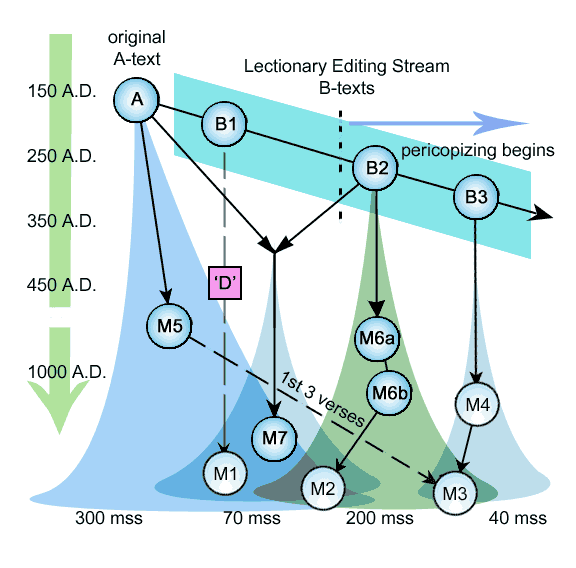
..A few comments are in order:
M5 & M6: Although all the manuscripts themselves except perhaps Codex 'D' (Bezae) are post 5th century, in the case of M5 and M6, their sheer numbers imply that they contain much older and popular texts.
M7: Other investigators have noted the mixture in M7. However, because of the large number of M7 manuscripts (70 mss) it is reasonable to project the archetype (original mixer) much further back than the extant M5 and M6 manuscripts, rather than have M7 directly derive from M5 and M6 in a misleading manner.
M3: Besides being apparently dependant upon M4, the mixed text of M3 is only represented by a handful of manuscripts, suggesting a very late start and lack of popularity.
Both the block-copied groups are obviously secondary and of little use in reconstructing the early history of the streams of transmission.
M4: Although M4 is a very evolved version of the Lectionary text, the fact that it can be traced at least to the 9th century, and is represented by at least 40 manuscripts suggests an early date for this 'final edition' of the Lectionary. It may go back to the time of Eusebius or even earlier, but not early enough to gain popularity.
M2: Since M2 has its closest relation to M6 (in fact it differs in only two significant variants), it seems reasonable to suggest it is just a result of the dominant M5 text influencing the M6 stream.
M1: Paradoxically, the M1 text is the only group having one really ancient Uncial manuscript. But this shouldn't be exaggerated, since even this Uncial (Codex Bezae) doesn't follow the 'M1' text very closely, but is as idiosyncratic here as it is elsewhere.
What the existance of M1 does seem to show is that the early Lectionary text began as almost a 'free form' type of paraphrasing, much as preachers and evangelists teach from memory or in public address today. In M1 we have a random snapshot of the early Lectionary as it began to be modified for public reading and liturgical purposes.
Codex Bezae will always be of interest as an early bilingual document reflecting an even earlier period of the text before centralized control was exerted upon it. Like the complimentary papyrii from Egypt (P66 & 75), it gives us a tantalizing peek into the way the gospel texts were handled and modified for public consumption and preaching.
M1, M2, and M3 appear to form a line or progression of the text-editing process. Yet the detailed examination has shown that they are not directly dependant upon one another, but only appear so, because they reflect much earlier editing process which took place behind the archetypes they depend upon.
It will be handy to recall von Soden's introductory description of the manuscripts, to see how it fits together with our analysis:
by Von Soden (translated from the German by Nazaroo);
Section 49. Orientation:
The majority of the mss that contain John exhibit after 7:52 a pericope which interrupts the connection of 7:52 with 8:12, having Jesus' judgment over an accused adulterer as the subject. I name it "Adultery"(Moixeia in Greek) and designate it with the Siglum "μ"(Greek 'mu' = m).
Pericope Form Indicates Text-type:
This pericope is of great importance for the textual criticism of the gospel. For the form in which it appears in a given manuscript is very often an indication of the affiliation of the Codex concerned to a family, a type, or a version, a measure of acknowledgement of its source
This is usually so, but not always, since, as will be it shown, the pericope was in no place neutral. The text is frequently corrected by subsequent readers in all ages, and this evaluation (by correctors) varies much in the course of time, although sometimes individually is clear. Regarding the changing fate of the Pericope as such, its actual appearance (and disappearance) in text-types and versions will have to be shown. Here, where it only concerns the changing wording of the pericope's form, some provisionary words to orient the reader are sufficient.
In a significant number of mss among the oldest which we possess, the pericope is missing completely. In other mss it is sometimes of the hand of the scribe, sometimes of a later hand, sometimes at the margin by 7:52, sometimes joined at the end of John's gospel, and in one group of texts inserted even in Luke after 21:38. (family 13)
Text-critical Markings:
Frequently it is accompanied by a text-critical remark, whose different style indicates its (later) date. But in the vast majority of the mss however it stands between 7:53 and 8:12 in the text, except that about half of those are provided with critical marks in the margin at least. These marks sometimes start themselves instead on 8:3-11.
Confusion from Reinsertion and Deletion:
Occasionally (or in reverse) only 7:53-8:2 are missing or else 8:3-11. This therefore suggests that in later times the narration was inserted from a Lectionary.
The Lection however began only at 8:3. So if a scribe restoring the pericope in a mss should correct with the Lectionary, either by memory or by the Lectionary itself, he would only begin with the insertion at 8:3.
Turned around, for the same reason if it should be erased using an (earlier) Lectionary tradition (as a guide), in the copy only the lection portion will be removed, so that 7:53-8:2 remained standing.
When a manuscript then containing 7:53-8:2 was corrected by a copy containing the passage again, then the beginning of 8:12 will often be found before 3, that is at "legon egw emi..."
The Problem of 'Mixture':
The text of this homeless pericope, now picked up, now dropped again in the swing of mood, has experienced a measure of variants like no other part of the NT.
And this isn't just with every new text revision. But also in individual mss as noted above, particulars have been taken from circulating revisions as versions were brought together over and over again.
Dispelling the confusion nowhere seems as hopeless as with this 'vagrant', evolving through all the conceivable phases thought possible to repair a witness by addition or ommision.
The fact we've still succeeded in illuminating her original form again and her colorful, confused past, holds up a promise: that she herself will also allow us to pursue the history of the text of the whole written collection around which she is merely fluttering like a scarf, to approach her origin.
For all the neutral texts, existing transcripts of the pericope were
collated exactly. There was very close to a thousand manuscripts. At
first the picture became ever more nebulous. But bit by bit lines met,
and, and by pursuing them, certain forms stood apart.
Two Dominant Texts:
Among those marking themselves most sharply were two forms of the pericope which strove for supremacy primarily in the Middle Ages, also soon mingling with one another, then displacing each other. Against them the other types then stood out ever more clearly.
(end of section 49, pg 486-487)
Here we can see that von Soden was not only acutely aware of 'mixture' (block-copying), he even gave a very detailed and plausible explanation for key features, such as the copying of the first three verses of μ5 by μ3 (i.e., the copying of Manuscript Group 5's text by Manuscript Group 3.)
Even more importantly, von Soden was able to plausibly account for the peculiar omissions in some manuscripts of only the first three verses, or else the last 7, by turning to the LECTIONARY tradition, and the attempt to restore the text from that source by copyists.
This was in fact the source for both the variations in the extent of omission, and also the actual form of one of the dominant texts (M6), as well as many individual variants.
We are now about ready to place our stemma into the bigger picture:
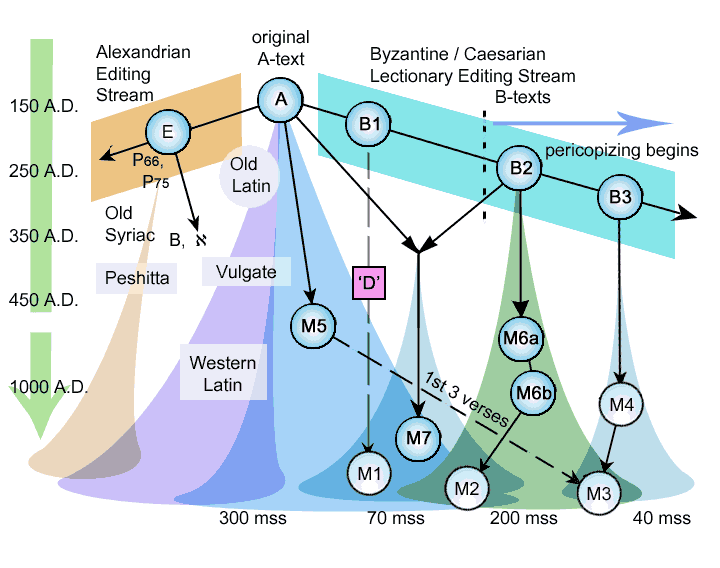
We can see that the Roman (Latin) tradition, following Jerome is really closer to the Byzantine (Eastern Orthodox) tradition than to the Alexandrian tradition.
The primitive Alexandrian lectionary text was the most extreme case of editing upon the text. This over-editing was brought back in line fairly quickly, and outlived its usefulness and its reason to be, once Christianity was legalized and became the dominant religion in the Empire. The Alexandrian textual activity had an impact upon all the early translations, including the Latin and the Old Syriac. This was natural, since the first evangelizing efforts would find lectionary texts of more use than private copies of the Gospels. But the Romans quickly demanded more accurate copies, and Jerome's Vulgate was a natural evolution, and a restoration of the text via the original Greek.
Although the early fathers acknowledged the problems that the Pericope de Adultera posed, in the end they did not adopt the Alexandrian extreme solution of deletion. Instead, they relegated the public reading of this section to obscure saint's days in the final form of the Lectionary tradition. It does not matter that this solution was rather late on the scene. This was the practice finally adopted and confirmed by all branches of the church, including the Syrian and African.
At first it appears odd that the Syriac (Eastern) text would also be dependant upon the Alexandrian (African) lectionary edits. But this is not so surprising when we consider that it probably made its way there with Origen when he fled Egypt, and established himself in Syria for a time.
Later, when Origen's admirer Eusebius, under patronage of the Emperor Constantine was given authority to oversee the production of expensive and luxurious bibles, he naturally adopted the Alexandrian texts of his mentor. But although the Alexandrian text had such prestigious support, it also died out quickly, remaining a minority text, as grassroots copies of the Byzantine text on the Eastern side of the Empire continued to multiply and spread.
Nonetheless, it was doubtless this second spurt of popularity for the Alexandrian text that resulted in leading astray a portion of the later manuscripts to excise the Pericope de Adultera. This in turn led to the attempt to save the passage by hiding it in Luke temporarily (as in family 13) or tacking it onto the end of John's Gospel (as in family 1).
Conservative Catholic scholars have always recognized the authenticity of John 8:1-11, and even most conservative Protestants have realised it cannot be jettisoned without severe damage to the credibility of arguments for the inerrancy and divine preservation of scripture.
Because of this, the Alexandrian text, although adopted by secular scholars as an alternative to Christian texts, will never acquire any dominant position or present serious competition for the traditional text of Holy Scripture. Christians will always prefer their texts unmutilated, not tampered with by self-appointed scholars.
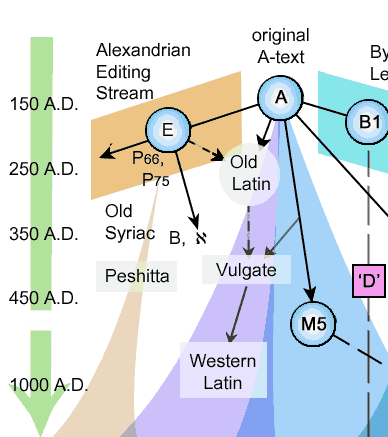
Jerome was probably one of the most careful editor/translators of the New Testament. For his new translation of the Gospels (390 A.D.) he did not rely upon earlier translations, but for accuracy was compelled to go directly to the Greek, and begin afresh. His meticulous (almost anal-retentive) care and concern for accuracy drove him to gather to himself the oldest and most reliable witnesses to the text of his time from throughout the empire, and with the authority of the Bishop of Rome under the Emperor, he had the best access to all the data then available.
Taking Jerome's testimony at face value (he is hardly likely to have falsely represented his own methodology or the Latin tradition as he actually found it), we can say that Jerome acknowledged the influence of the extreme Alexandrian practice of omitting the passage upon the Old Latin, but saw it as minimal. Obviously the corollary to "many ancient manuscripts include the passage" is "a small number of manuscripts omit the passage". (we represent this with a dotted line in the diagram).
Similarly, Jerome consulted the Old Latin manuscripts, but deferred to the best and oldest Greek witnesses he had available, as well as using a 'modern' (contemporary) form of Latin for his translation. The result was the Latin Vulgate.
Jerome was not impressed with the Alexandrian practice of omitting the passage, and he included it in his own translation, with strong testimony of its authenticity as Holy Scripture.
Even though many other contemporary early fathers contended with Jerome concerning doctrines and also his translations of the Old and New Testaments, they were unanimous in agreeing with him about the authenticity and pedigree of the Pericope de Adultera. This in itself is remarkable testimony to the accuracy of Jerome's Greek manuscript base, and his integrity regarding the known state and history of the Greek and Latin textual transmission streams.
Another point in this same vein is that obviously Jerome's Latin text closely follows the Byzantine text, and also the traditional Greek Orthodox Bible (LXX) as well.
This is strong testimony that well before the 4th century the Byzantine text-type was already an ancient and respected line of transmission for the Gospels.
Limits of Alexandrian Influence upon the Textual Stream
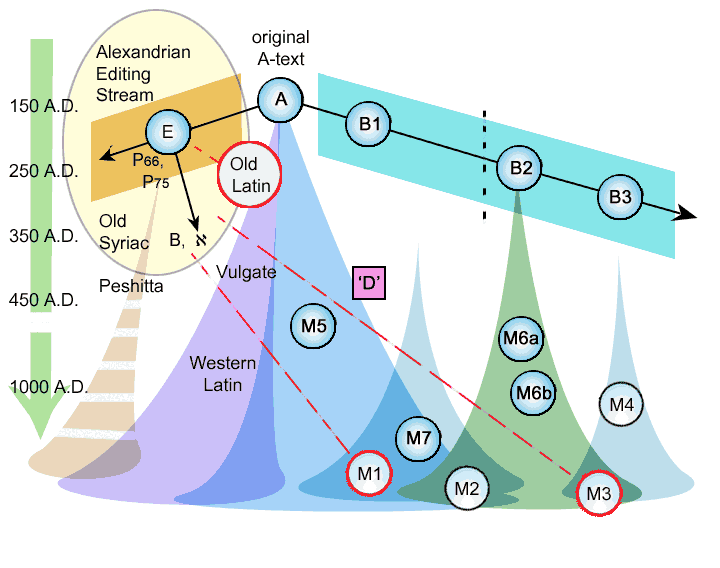
The Alexandrian Editing style penetrated into the textual stream very early, in the early 2nd century, but probably did not evolve into a stable or locally dominant 'text-type' until the mid or late 2nd century.
In spite of its local prestige, this text quickly waned in importance, and held little sway over the rest of the empire and independant lines of transmission. It only seems to have spread with the persecutions in Egypt around 150 - 200 A.D. and the flight of Origen to Caesaria. From here, it probably spread again to local Eastern translations in the 2nd and 3rd centuries, such as the Syriac and possibly the Georgian and Armenian.
The Eastern Byzantine half of the Empire seems to have been largely impervious to the influence of the Alexandrian scribes, and this is probably because the Eastern empire was actually the home-base and central location of most of the early churches, founded by Peter, John, and Paul.
Also, Greek was the native language of the Greeks, Phonecians and most of the Eastern Mediterranean. They were quite capable of preferring and defending their own independant apostolic traditions.
Although achieving a 'second wind' with the influence of Eusebius and Constantine, the Alexandrian text quickly died again.
Its only lasting influence seems to have been on a portion of the Old Latin, and local texts like the Northern Egyptian (Bohairic and possibly Sahidic) translation.
Even the Syriac was rather quickly (by the 4th or early 5th century) corrected to include the Pericope de Adultera.Obviously the Syriac fathers acknowledged and consented to the authenticity and priority of the Greek text.
Finally, we see the last bit of indirect influence in the two groups M1 (family 1) and M3 (family 13). Here, the omission was reintroduced again around the 10th century, probably through the Old Latin or older Lectionary traditions.
Here some manuscripts in the M1 group place the passage at the end of John. This is no surprise, nor an indication that the passage was thought spurious. This was actually the only practical way of correcting a manuscript with such a large omission.
The M3 group is unique in that some early scribe obviously attempted to save the passage by hiding it in Luke. Probably under orders to omit the passage, this scribe appears to have disobeyed his orders, and hence family 13 was born.
Both of these small and partial influences of the Alexandrian text upon the Byzantine transmission are mere blips on the radar screen, echoing a much older and near-forgotten battle over the verses.
The situation with the Alexandrian 'text-type(s)' is completely opposite that of reconstruction of the Byzantine (Traditional) text.
Why? Just like the Byzantine text-type, the Alexandrian line of transmission stretches across three or more centuries, from 50 A.D. (the date of the writing of Paul's letters) to about 350 A.D. (the date for Codex Vaticanus).
And just like the Byzantine text-type, the Alexandrian line of transmission must have involved thousands of copies of the Gospels on papyrus.
But UNLIKE the Byzantine text-type, the Alexandrian has virtually no further manuscript support after the 4th century when it essentially died out.
So while the Byzantine text-type and lines of transmission are represented by literally thousands of fairly independant manuscripts, the Alexandrian lines of transmission are only represented by a handful of manuscripts plus a few fragments (at least for the Gospel of John).
The sheer magnitude of the problem can be shown by analogy. A genealogical tree or complete stemma of the transmission stream can be likened to a photograph. Like a photograph, there will be many interesting details. Yet at the same time, large portions of the photo may be very similar, such as the sky, or a pond, or a clump of trees. However, in isolation, these areas of the photo will appear quite different from each other.
If we take the photo and recreate a large jigsaw puzzle out of it, say a 2000 pc. puzzle, we can immediately get a feel for the problem of putting each small piece (a manuscript) in its proper place. There may be many false starts, and 'good' but wrong fits.
But with at least MOST of the pieces there is reasonable hope of assembling large portions of the picture and even reasonably extrapolating missing pieces, or even whole sections, based upon congruencies and expectations which the rest of the picture provides.
But the situation for the Alexandrian stream is more like a case where we only have a HANDFUL of pieces from a 2000 piece jigsaw puzzle. Even though we can 'group' the fragments into similar piles, we really can't say with any certainty at all what the picture really looked like:
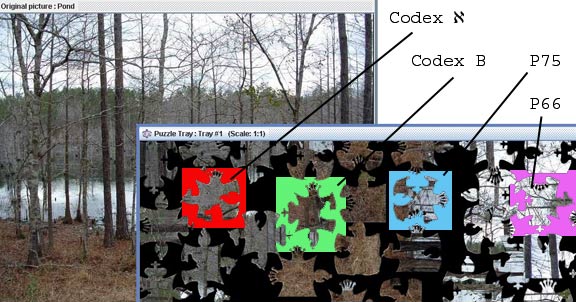
There just isn't enough details in a handful of manuscripts and fragments: the loss of critical information is catastrophic.
... as it would have been for the Byzantine line of transmission, except in that case we have thousands of later copies, which form easily detected families and groups. From that kind of base (the Byzantine manuscripts) we can have reasonable hope of constructing an outline of the history of transmission.
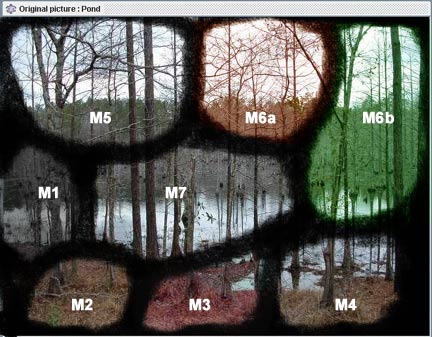
The picture analogy is quite different. The number and extent of indendant witnesses to textual variants gives us a good idea of the age and spread of the readings, and a much clearer and more accurate picture of the transmission process.
The basic result is that we have a huge blank chart for the Alexandrian 'Stemma', with a mere four or five manuscripts for John on it.
These manuscripts can be placed according to their rough date, and even a few lines of dependance can be drawn, indicating some shared readings. But after that, nothing more can be done:
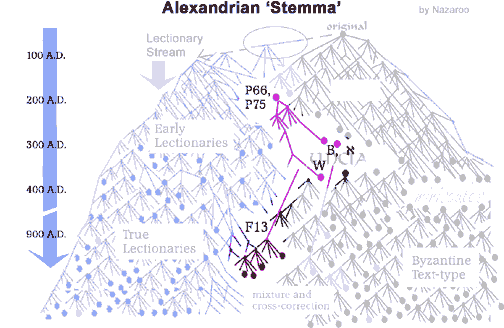
The best that we can do with Aleph (Sinaiticus), B (Vaticanus), P66 and P75 is make a handful of lists of shared readings between pairs and triplets of manuscripts. Once this is done, no real progress can be made after this.
Why?
Why can't we treat individual manuscripts the same way we treated the groups of manuscripts and families in the Byzantine stream? Couldn't we reconstruct a stemma from their shared readings?
No.
The problem is this: Suppose we have a shared reading even between P75, Vaticanus and Sinaiticus that differs from the standard text. Thus we have a reading found in one manuscript from 150 A.D., also found in another manuscript from about 200 A.D., and apparently copied also by a manuscript from 350 A.D.
What does it mean? Is the reading a lost original reading, or was it actually invented by the scribe of P66? We don't know.
Was it the reading of the majority of manuscripts in Egypt, or just an odd error of haplography that got copied by three manuscripts in a freak pattern of transmission? We can never know.
What's worse, we have no statistical base at all to make reliable conjectures from. It's one thing to say a reading must be much older because we found it in hundreds of manuscripts from the 2nd century. It is ridiculous to argue from 'statistical probabilities' based upon three manuscripts out of a set of many thousands that are completely missing.
The Alexandrian text is essentially dead, unless someone were to make at least several dozen more archaeological finds all over Egypt, each with a cache of hundreds of manuscripts and fragments of the Gospel of John.
Surely its not that bad, someone will say. Don't we know the essential character of the Alexandrian text? In general terms perhaps. We know the editing principles and we have examples of its implimentation.
Don't we know the essential content of the Alexandrian text? Unfortunately no. The few manuscripts we have disagree with one another far more often than they agree. This can only mean one of three things: Either,
(1) the Alexandrian text-type went through a rapid and extreme amount of change over a mere two centuries, or
(2) the Alexandrian text-type was so loose, that any random sample of three or four manuscripts would show the same amount of random variation, or
(3) these four or five manuscripts simply don't represent the Alexandrian manuscripts well at all. They are just badly executed or edited copies that exaggerate or mislead us about the true state of the text in Egypt from the 1st to the 4th centuries.
And with only three or four manuscripts, we really can't say with any certainty what the true situation is. It would be like conducting a poll from a woefully underrepresented populace with no knowledge of even the conditions under which the poll was taken.
An 'Alexandrian' text of sorts could be published, and indeed this is precisely what the UBS/Nestle text represents: a text reconstructed out of the readings of a handful of manuscripts, with a horribly incomplete set of footnotes even for the half-dozen manuscripts of interest.
But this text cannot even hope to claim that it is an accurate representation of the Alexandrian text, (if there was one), let alone the original New Testament.
In fact the situation is so ambiguous, the best and fairest stemma for the Alexandrian 'text-type' would be something like this:
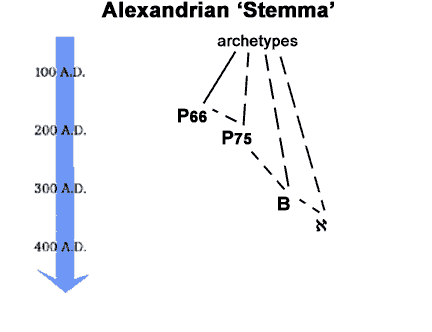
Note carefully the following: the dotted lines indicate either partial dependance, or unknown extent of dependance of one manuscript upon another or the unknown extent of 'mixture' and/or cross-correction in the copying lines.
The lines themselves may represent multiple generations of manuscript copies and cross-pollenation of readings.
One key concept here is that of the three basic options listed above, only Option (1) would allow a genealogical dependance of some kind between these manuscripts.
Furthermore, only Option (1) would allow us to use the actual agreements between the manuscripts against all other witnesses as the potential original reading.
(1) the Alexandrian text-type went through a rapid and extreme amount of change over a mere two centuries
That is, if we want to displace the traditional text for Alexandrian readings, then we are necessarily admitting a genealogical relationship between them, stretching back to the original exemplar.
Supposing the Obvious: - A Relationship between the Four Oldest Manuscripts.
But if we do this, we have to admit that readings in which they DON'T agree become immediately suspect.
To put it plainly, The unique readings of Codex B or Aleph will be rejected, because they are the most recent manuscripts of the bunch. They become the lowest priority manuscripts.
Ranked next would be agreements of Codex B and Aleph against all others: again, secondary in comparison to readings of the Papyrii P66 and P75. The earlier Papyrii would have precedence, if there is a genealogical relationship that makes the Uncials secondary. This would be re-enforced strongly if there were any agreements between the papyrii and the traditional text against the two 4th century uncials, which there actually are!
Finally, When the two papyrii (P66 and P75) disagree, we would have to appeal to the independant transmission lines of the traditional text again to break the tie.
(1) However we turn, we must consult the traditional / majority / Byzantine manuscripts.
(2) And to appeal to genealogy to support the 'special' readings of the oldest four manuscripts, we would have to logically give the papyrii priority, NOT Aleph and B.
The Horrible Alternative:
The only way one could take the agreements of Aleph and B over the readings of the papyrii would be to admit that the papyrii are independant of the Uncials, and were 'influenced' by the traditional text readings. But this places the existance of the traditional readings in question back before the existance of the earliest manuscripts.
In that case, the agreement of both the papyrii and the traditional manuscripts against Aleph and B takes precedence again! Because if the papyrii are independant of Aleph and B, and also 150 years earlier, why wouldn't we take their readings over the Uncials, especially if they agree with the traditional text?<
For many readings this actually makes some sense. We expect singular readings in the papyrii to be secondary and when the traditional text and the others side against any singular reading in a manuscript, we should assume that manuscript or its archetype is guilty of an error.
But when is a reading 'singular'? When only one manuscript or possibly two agree against the rest. (You could have two if the second is dependant upon the same archetype, or dependant directly upon the first through some line of transmission of any number of stages.)
Now we feel the force of the predicament of only having one or two manuscripts for many readings. We cannot take a reading only supported by one or two manuscripts against the entire manuscript tradition.
And yet for many readings, (i.e. the 'Alexandrian' readings), THAT'S ALL WE HAVE: one or two manuscripts.
And once any kind of genealogical relationship at all is admitted, as it must be to group the manuscripts together as 'Alexandrian', the support of one or two manuscripts is simply uncompelling.
Again the traditional reading must be held until strong and convincing reasons suggest we should do otherwise.
Trying to reconstruct the 'Alexandrian text-type' is like trying to solve the John F. Kennedy assassination, when you're only allowed to question 3 hoboes, and the hoboes may actually be C.I.A. or FBI double-agents. You can't question anybody of importance, and everyone's a suspect! The clincher is that the witnesses don't really agree on much. It's like a Pink Panther movie.
